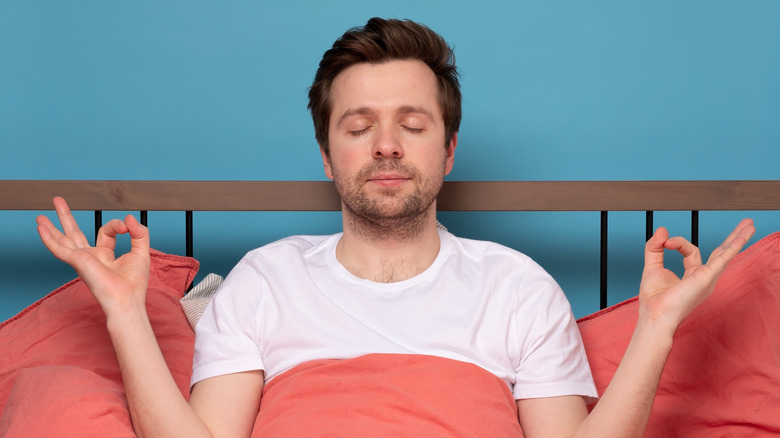Everything You Should Know About The 4-7-8 Breathing Technique
If you struggle to conjure up a handful of scenarios from the last week in which a solid relaxation technique would have come in handy, consider yourself ahead of the game! You're either one lucky duck or supremely zen. For some, stressful situations might not be as easy to brush off. But luckily, when life tries to ruffle our feathers, there are some very simple things we can do to restore inner balance.
Popularized in 2015 by Dr. Andrew Weil, founder of the Arizona Center for Integrative Medicine, the 4-7-8 breathing technique is a tool intended to help you gain control over your emotions in times of stress through controlled breathing (per Verywellmind). This concept isn't new, of course. Weil was inspired by pranayama, an ancient yogic breathing practice.
Designed to connect the body and mind, pranayama involves controlled breathing sequences in which the timing, duration, and frequency of each breath is regulated by the practitioner (per Healthline). Weil's technique seeks to do much of the same. So, if you're looking for the key to your inner calm, here's everything you need to know about the 4-7-8 breathing technique.
Benefits of 4-7-8 breathing
Weil offers up the 4-7-8 breathing exercise as a way to reduce feelings of stress and anxiety and control emotional responses to stressors (per Medical News Today). In a patient handout from the Arizona Center for Integrative Medicine, the 4-7-8 breathing technique is referred to as "a natural tranquilizer for the nervous system." Verywellmind explains that this works when stressful situations arise throughout the day and our sympathetic nervous system is activated, triggering that "fight or flight" feeling. Deep breathing activates the parasympathetic nervous system, which suppresses the stress response and elicits feelings of relaxation.
A 2019 review published in JBI Database of Systematic Reviews and Implementation Reports backs this up further, pointing to a number of studies that demonstrated how diaphragmatic breathing could improve both physiological and psychological symptoms of stress.
Healthline reports that 4-7-8 breathing is also supposed to improve sleep quality by supplying the organs and tissues with a healthy dose of oxygen and inducing a state of deep relaxation, even suggesting focused breathing might help some fall asleep faster by steering the mind away from the intrusive thoughts that sometimes sneak up at bedtime.
How to do it
If you're ready to see what this breathing technique is all about, Medical News Today suggests starting by getting yourself into a comfortable seated position and placing the tip of your tongue just behind your two front teeth. When you're ready, exhale — totally emptying your lungs — before breathing in deeply and quietly through the nose for four seconds. With your lungs filled with air, hold your breath and count to seven. Pursing the lips, exhale through your mouth for eight seconds. This should make a sort of whooshing sound. You may repeat the breathing pattern up to four times. As this kind of breathwork might cause dizziness or lightheadedness when you first begin, it is recommended that you try this sitting or lying down and doing no more than four rounds until your body becomes adjusted.
Those who have a hard time holding their breath are welcome to make adjustments. If you find yourself struggling with the duration of the breaths, instead of four, seven, and eight seconds, try two, three and a half, and four seconds. As long as the ratio remains the same, you should still enjoy the benefits, according to Medical News Today. And to start seeing them sooner, Weil recommends practicing this exercise twice a day. The longer and more frequently you use the technique, the more effective it is said to become.



